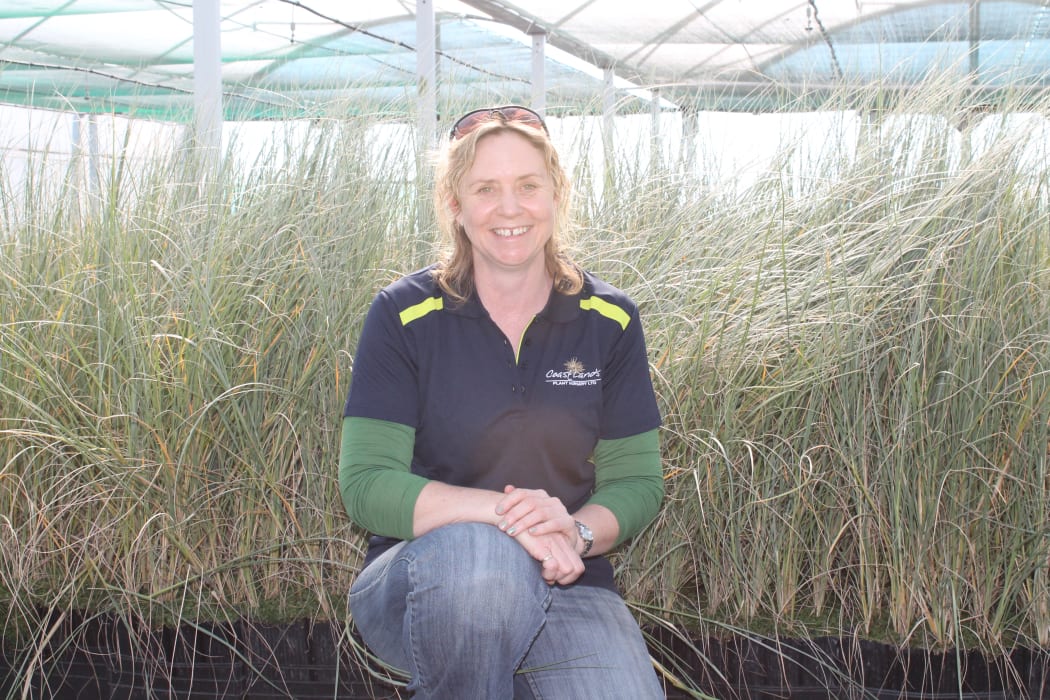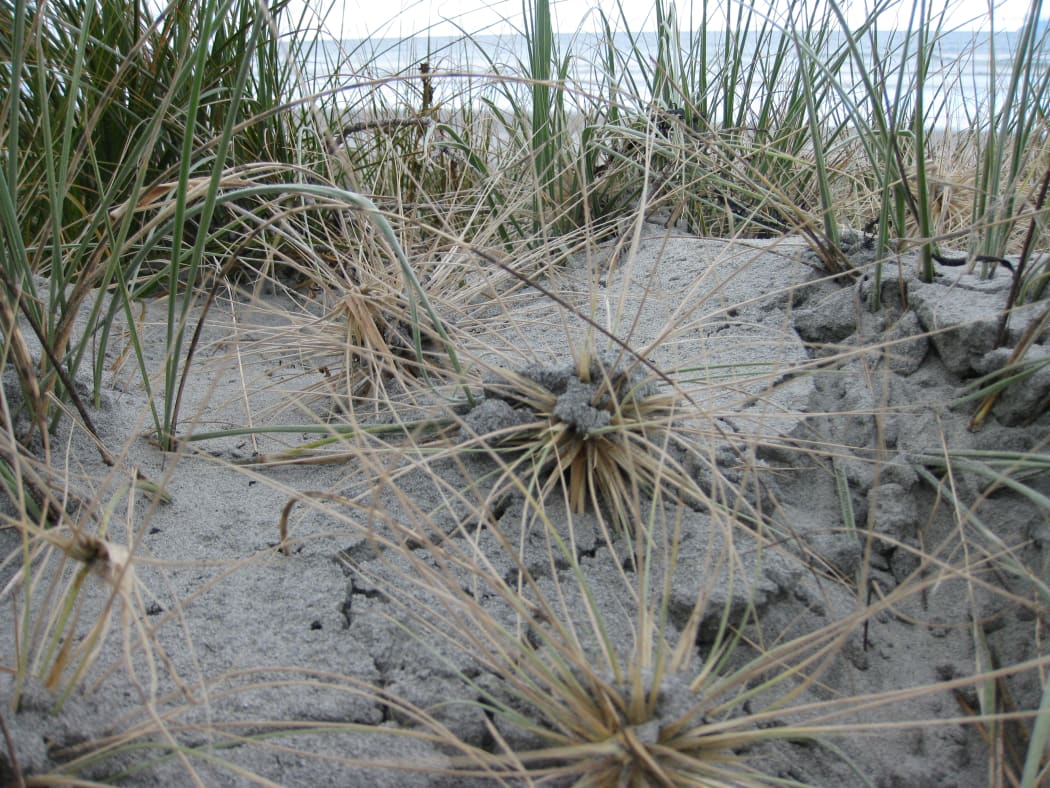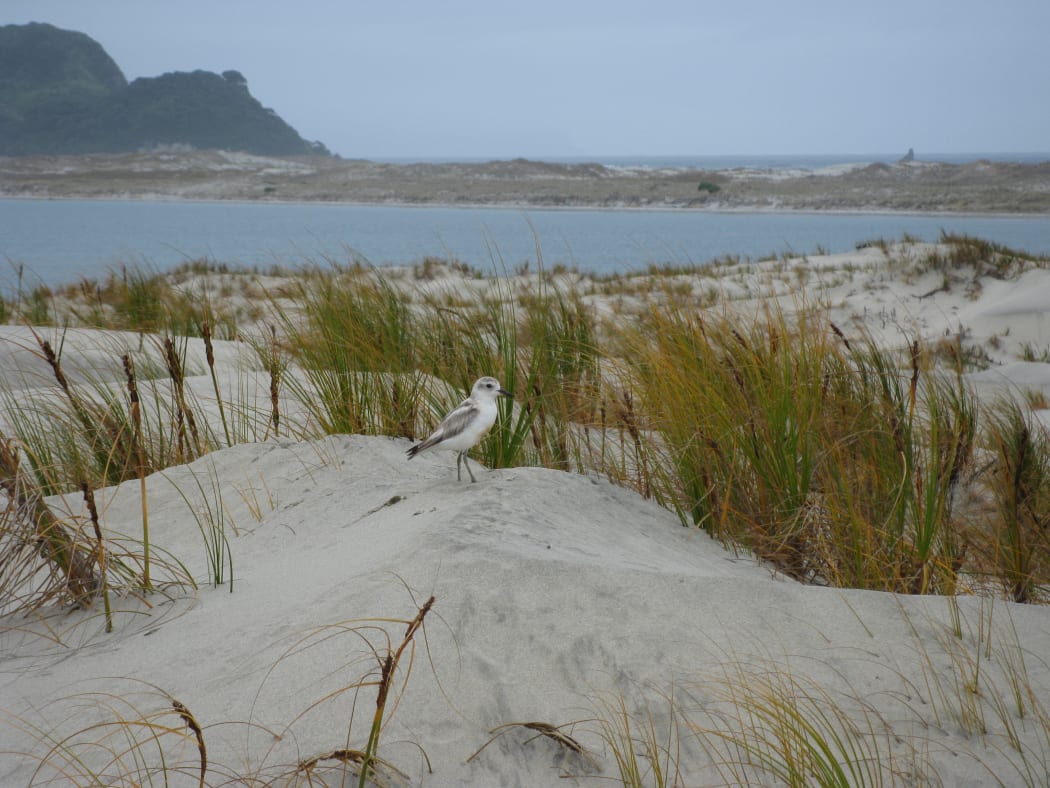New Zealand’s iconic native sand dune plants, pingao and spinifex, are getting a helping hand from a dedicated horticulturalist.
Jo Bonner is so committed that she has been known to chase down the beach on a windy day in pursuit of the best – and fastest – rolling spinifex seed heads.

Horticulturalist Jo Bonner, in front of hundreds of spinifex plants growing in a shade house at Coastlands Plants. Photo: Coastlands Plants
Subscribe to Our Changing World for free on Apple Podcasts, Spotify, Stitcher, iHeartRADIO, Google Podcasts, RadioPublic or wherever you listen to your podcasts
Each year, horticulturist Jo Bonner and the team at Coastlands Plants in Whakatāne grow 200,000 spinifex plants and 100,000 pingao plants.
They’re the largest supplier of these in the country and their plants are used by councils and coast care groups in dune revegetation programmes around the North Island.
“The most important thing about the foredune plants is their ability to fix the dunes after a large storm event,” says Jo.
The key, in the case of spinifex, is long vigorous runners which grow towards the sea and quickly cover foredunes ravaged by storm swells. The hairy plants then trap wind-blown sand which rebuilds a gentle dune.
“Both spinifex and pingao are our fall guys – they’re the ones that take the brunt of the storms.”

Pingao is a native sand binder, which loosely holds sand dunes. Mangawhai Beach, Northland. Photo: Coastlands Plants
Jo says that widespread introduced marram grass, planted in the past to provide food for stock being driven along the beaches, doesn’t bind sand dunes during a storm; it simply washes away, making it much less effective than the two native species at protecting the coast.
But while both native sand binders, spinifex and pingao, do a great job in holding and rebuilding sand dunes, life in modern-day New Zealand is not easy for them.
Jo says that pingao was once widespread but has slowly disappeared in many parts of the country. It is eaten by rabbits, and its seeds are eaten by rodents and introduced birds.
Jo reports seeing big flocks of sparrows feeding in front of her team when they are out collecting seeds at various beaches, and sparrows are also a big problem at the nursery.

The Coastlands Plant nursery team collecting spinifex seed heads at a local Whakatāne beach. Photo: Coastlands Plants
Coastlands Plants has been in the nursery business for many years.
The revegetation process begins with seed collection, and Jo says it is important to collect seed that is local to each beach.
Nursery staff collect in the Whakatāne area, while local coast care groups collect in their own areas.
Peak seed production coincides with Christmas and busy holiday times at local beaches and Jo says that sometimes just finding a car park can be a challenge.

Spinifex seed heads trapped in sand with adult plants behind. Spinifex is native to New Zealand and is an important component of sand dune ecosystems as it traps and holds sand. Waihi Beach Photo: Coastlands Plants
Having braved the heat and the summer beach goers, the collectors send their seed to the nursery where the time-consuming process of germinating and growing begins. Jo says there are plenty of problems to overcome.
One issue facing spinifex and pingao has been a decline in seed fertility.
“We used to get 50-80 seeds from each spinifex seed head,” says Jo, referring to the iconic spiky spinifex seed head that you see rolling down the beach on a sunny day. “Nowadays it can be as little as 15 seeds per head.”
She suspects that changes in the prevailing winds might be affecting fertilisation for the plants, as the species has male and female plants and relies on wind pollination.
“But as a basic rule west coast beaches have way more pollinated seeds than east coast beaches.” Wide beaches also have better germination rates.
Foxton Beach, she notes, is an excellent source of seeds.

A New Zealand dotterel amongst pingao growing on sand dunes at Mangawhai Beach, in Northland. Photo: Coastlands Plants
Jo says it’s always rewarding to return to a beach where a local coast care group has been at work and to see her plants thriving.
She also says that it’s important not to walk or drive over sand dune plants, as it’s very easy to damage them. And destroying the plants damages precious sand dunes which are playing an increasingly important role in protecting our coasts from the impact of sea level rise.
Listen to the full podcast to hear more about Jo’s work helping restore native sand dune communities.


